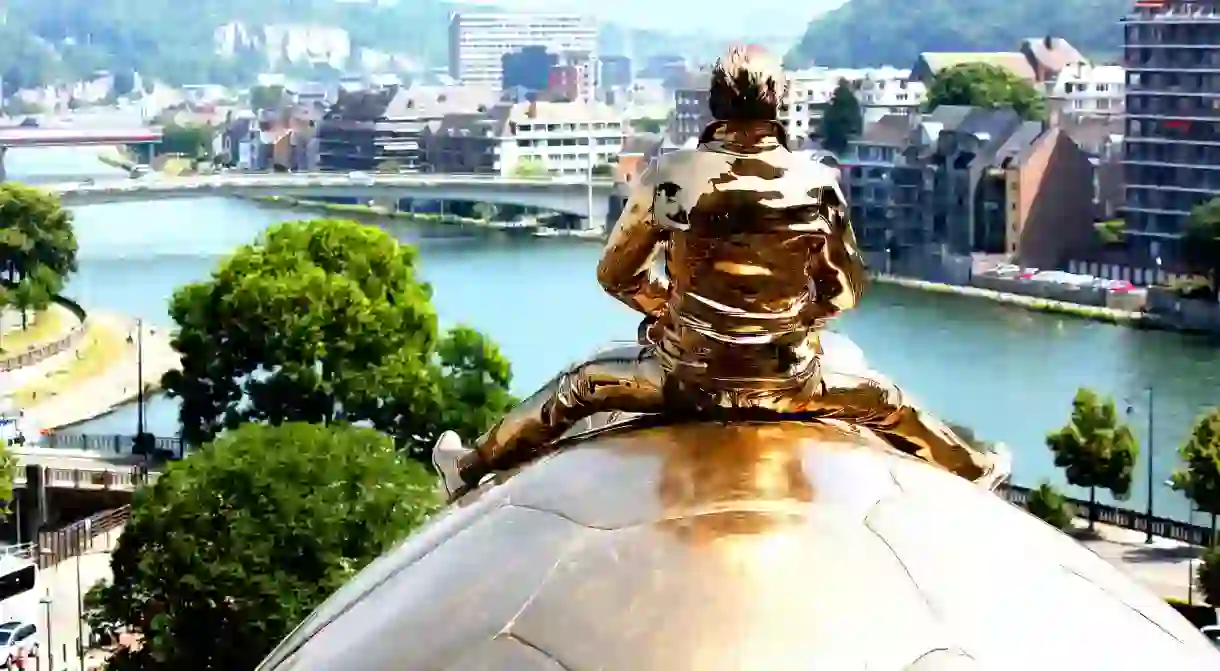Stunning Public Works by Belgian Contemporary Artist Jan Fabre

He has thrown cats off a city hall’s steps (none were injured) and plastered a university lecture hall with slices of smoked ham, but perhaps most intriguing about Jan Fabre’s oeuvre are his permanent works made for the public space. Usually lesser in shock value and rife with big ideas, these five pieces by the hailed Belgian contemporary artist can’t help but speak to the imagination.
The Man Who Measures the Clouds
“It is an offering, a tribute, to my dead brother, Emile Fabre,” Fabre has said of The Man Who Measures the Clouds. In a poetic gesture, the bronze sculpture shows Fabre himself balancing on a small stepladder, both arms outstretched in an effort to do something impossible: measure the clouds by holding up a school ruler.
The statue is one of the artist’s more famous works, and Fabre has reproduced it a handful of times since its original creation in 1998. Most buyers, such as the Antwerp De Singel, Ghent’s S.M.A.K. Museum, and Japan’s 21st Century Museum, have placed the work on their rooftops for an additional effect, though the face, which is that of his twin brother Emile more than his own, becomes indistinguishable because of it.

Heaven of Delight
Glued onto the ceiling of the Hall of Mirrors inside the Belgian Royal Palace is a fabulous glittering green mosaic with slightly macabre resonances. The material for the breathtaking display is 1.6 million jewel beetle carcasses. It took Fabre and an army of 29 assistants four months to put together the iridescent ceiling and one chandelier. Its title, Heaven of Delight, echoes Hieronymus Bosch’s The Garden of Earthly Delights but takes on a darker meaning when aware of Fabre’s later explanations of the work.
According to the constant provocateur, there are secret symbols hidden in the beetle mosaic: severed hands, skulls, and giraffe legs. Fabre has claimed that they are there as a critical note to the Belgian monarchy’s role as the once colonizer of the Congo, though most visitors still haven’t noticed any figures other than the “P” for Paola, the art-enthusiast Queen who commissioned the masterpiece.

Searching for Utopia
This massive gleaming turtle made his debut on the beach of Belgian sea town Nieuwpoort for the first edition of the oceanside triennial Beaufort in 2003. It’s an imaginative self-portrait (Fabre is riding on the back of the sea creature) that embodies the most dreamy parts of the artist’s aesthetic. In Nieuwpoort, the 5.5-ton, seven-meter-wide (23 feet) mammoth initially stood staring at the ocean’s horizon and looking for Utopia from there. An unrelenting mix of wind, rain, and sand got the better of Fabre and his tortoise though.
Once restored, the sculpture will sit in a new square in Nieuwpoort, designed in cooperation with Fabre. Of course, transportation to another part of the public space is bound to heavily alter the meaning of an artwork dubbed Searching for Utopia. Case in point are the copies that Fabre has made, one currently looking over Namur from its Citadel and one at the Piazza della Signoria in Florence, Italy.

Totem
On the spacious Ladeuzeplein square, in front of historic student town Leuven’s impressive university library, a 23-meter-high (75.5 feet) needle leads the eye upwards. It pierces a giant jewel beetle lying on its back, its crawlers pointing towards the sky. The artwork was a gift to the city from the University of Leuven, which in the early 2000s celebrated its 575th birthday and gave Fabre carte blanche for the occasion.
Despite its initial surreal impression, the artist’s choice of the jewel beetle is nonetheless grounded in, admittedly, Fabre-esque logic. He considers the ancient creature as one of nature’s first computers, a mechanism full of radars and technology, a “kind of memory of nature”—not unlike the contents of a large university library.

The Man Who Bears the Cross
As it’s facing Peter Paul Rubens’ epic triptych The Descent from the Cross in Antwerp’s Cathedral of Our Lady, Jan Fabre’s latest gleaming self-portrait enters into a direct dialogue with the Flemish master, and with religious art in general. The Man Who Bears the Cross shows a Fabre not young and not old. He’s an everyman, elegantly balancing a large cross in the palm of his right hand.
The work isn’t adulating Christianity like Rubens’ is, but neither is it dismissing it. He is simply holding the weight of it in his hands, contemplating religion’s meaning for himself, maybe even suggesting to the surprised visitor that he or she do the same. The video below shows the installation of the sculpture in 2015, the first piece of a contemporary work of art added to the largest cathedral in the Lower Countries since 1924.
https://vimeo.com/146251311













